Geospatial Science: Report on Map Design and GIS Application
VerifiedAdded on 2023/06/06
|6
|1917
|359
Report
AI Summary
This report delves into the principles of map design within the context of geospatial science and Geographic Information Systems (GIS). It begins by defining GIS and its applications in map production, emphasizing the creation of thematic maps. The report then explores the process of transforming three-dimensional displays into two-dimensional maps using map projections, focusing on area and distance preservation. It covers map generalization, detailing which features to include and exclude, and discusses data classification schemes. The report also examines symbolization techniques for representing real-world features, including considerations for geographical dimensions, measurement levels, and data processing. Finally, it addresses map composition, including essential elements like the title, legend, and scale, as well as design principles such as balance, hierarchy, figure-ground relationships, and contrast. The report concludes by highlighting the use of GIS for spatial and statistical analysis of geographic data to produce various data outputs.
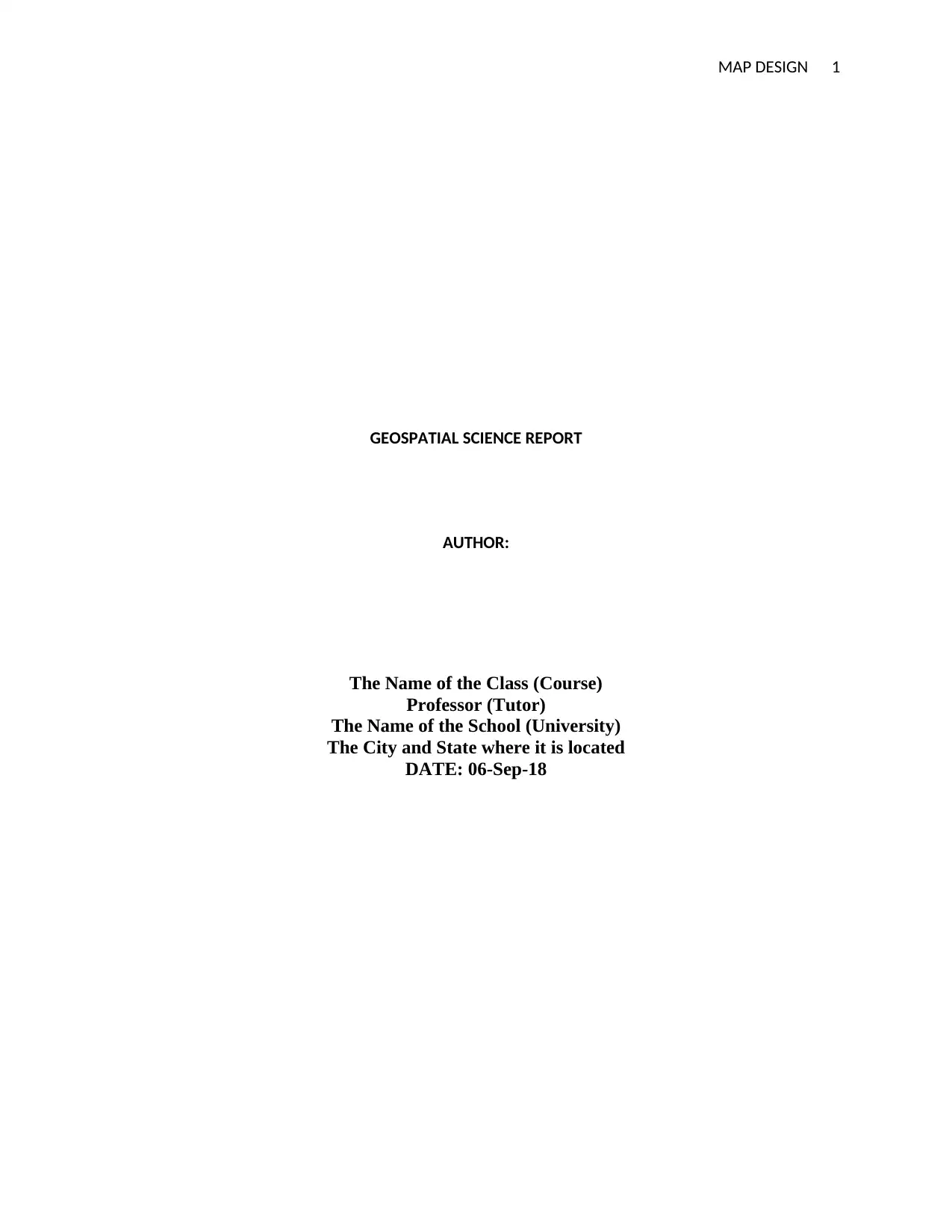
MAP DESIGN 1
GEOSPATIAL SCIENCE REPORT
AUTHOR:
The Name of the Class (Course)
Professor (Tutor)
The Name of the School (University)
The City and State where it is located
DATE: 06-Sep-18
GEOSPATIAL SCIENCE REPORT
AUTHOR:
The Name of the Class (Course)
Professor (Tutor)
The Name of the School (University)
The City and State where it is located
DATE: 06-Sep-18
Paraphrase This Document
Need a fresh take? Get an instant paraphrase of this document with our AI Paraphraser
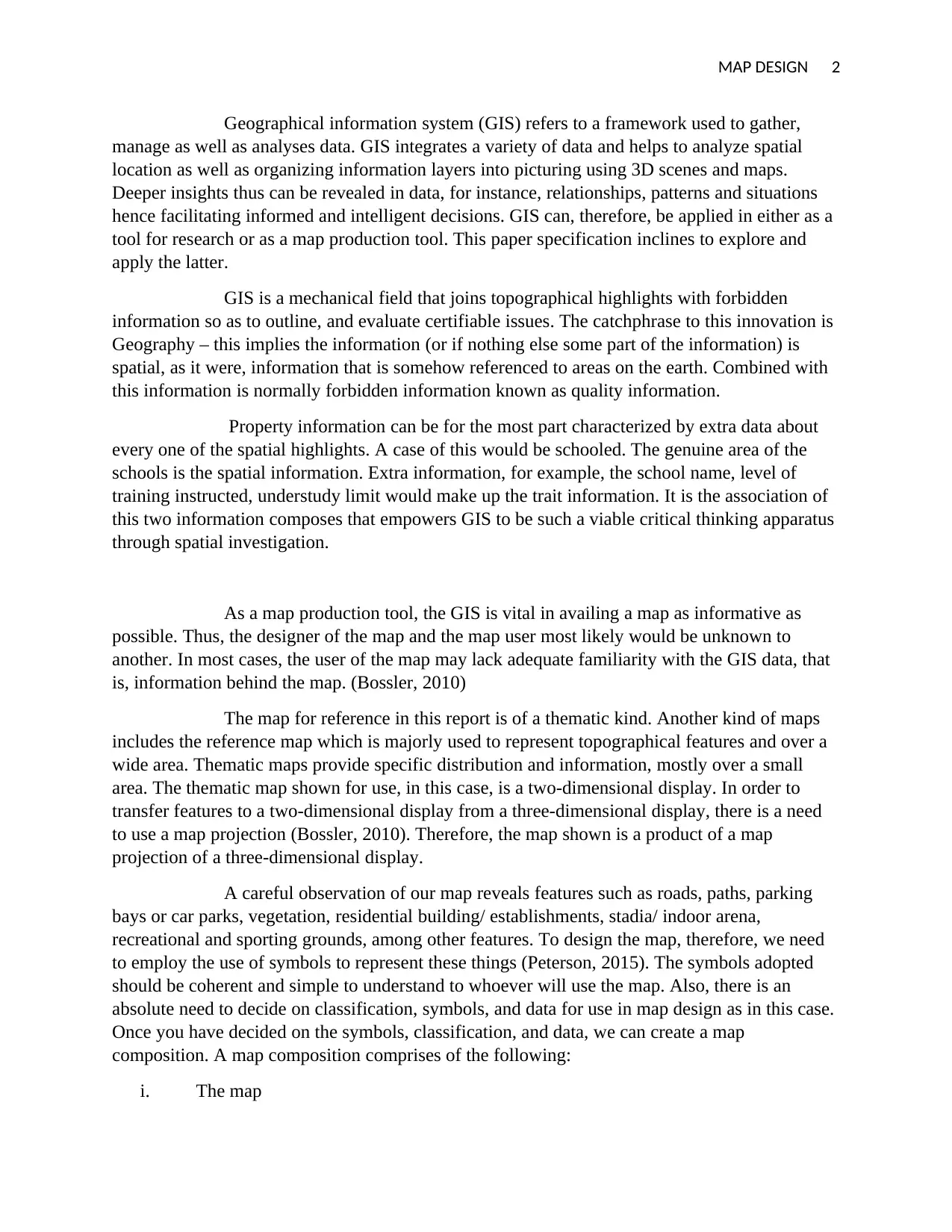
MAP DESIGN 2
Geographical information system (GIS) refers to a framework used to gather,
manage as well as analyses data. GIS integrates a variety of data and helps to analyze spatial
location as well as organizing information layers into picturing using 3D scenes and maps.
Deeper insights thus can be revealed in data, for instance, relationships, patterns and situations
hence facilitating informed and intelligent decisions. GIS can, therefore, be applied in either as a
tool for research or as a map production tool. This paper specification inclines to explore and
apply the latter.
GIS is a mechanical field that joins topographical highlights with forbidden
information so as to outline, and evaluate certifiable issues. The catchphrase to this innovation is
Geography – this implies the information (or if nothing else some part of the information) is
spatial, as it were, information that is somehow referenced to areas on the earth. Combined with
this information is normally forbidden information known as quality information.
Property information can be for the most part characterized by extra data about
every one of the spatial highlights. A case of this would be schooled. The genuine area of the
schools is the spatial information. Extra information, for example, the school name, level of
training instructed, understudy limit would make up the trait information. It is the association of
this two information composes that empowers GIS to be such a viable critical thinking apparatus
through spatial investigation.
As a map production tool, the GIS is vital in availing a map as informative as
possible. Thus, the designer of the map and the map user most likely would be unknown to
another. In most cases, the user of the map may lack adequate familiarity with the GIS data, that
is, information behind the map. (Bossler, 2010)
The map for reference in this report is of a thematic kind. Another kind of maps
includes the reference map which is majorly used to represent topographical features and over a
wide area. Thematic maps provide specific distribution and information, mostly over a small
area. The thematic map shown for use, in this case, is a two-dimensional display. In order to
transfer features to a two-dimensional display from a three-dimensional display, there is a need
to use a map projection (Bossler, 2010). Therefore, the map shown is a product of a map
projection of a three-dimensional display.
A careful observation of our map reveals features such as roads, paths, parking
bays or car parks, vegetation, residential building/ establishments, stadia/ indoor arena,
recreational and sporting grounds, among other features. To design the map, therefore, we need
to employ the use of symbols to represent these things (Peterson, 2015). The symbols adopted
should be coherent and simple to understand to whoever will use the map. Also, there is an
absolute need to decide on classification, symbols, and data for use in map design as in this case.
Once you have decided on the symbols, classification, and data, we can create a map
composition. A map composition comprises of the following:
i. The map
Geographical information system (GIS) refers to a framework used to gather,
manage as well as analyses data. GIS integrates a variety of data and helps to analyze spatial
location as well as organizing information layers into picturing using 3D scenes and maps.
Deeper insights thus can be revealed in data, for instance, relationships, patterns and situations
hence facilitating informed and intelligent decisions. GIS can, therefore, be applied in either as a
tool for research or as a map production tool. This paper specification inclines to explore and
apply the latter.
GIS is a mechanical field that joins topographical highlights with forbidden
information so as to outline, and evaluate certifiable issues. The catchphrase to this innovation is
Geography – this implies the information (or if nothing else some part of the information) is
spatial, as it were, information that is somehow referenced to areas on the earth. Combined with
this information is normally forbidden information known as quality information.
Property information can be for the most part characterized by extra data about
every one of the spatial highlights. A case of this would be schooled. The genuine area of the
schools is the spatial information. Extra information, for example, the school name, level of
training instructed, understudy limit would make up the trait information. It is the association of
this two information composes that empowers GIS to be such a viable critical thinking apparatus
through spatial investigation.
As a map production tool, the GIS is vital in availing a map as informative as
possible. Thus, the designer of the map and the map user most likely would be unknown to
another. In most cases, the user of the map may lack adequate familiarity with the GIS data, that
is, information behind the map. (Bossler, 2010)
The map for reference in this report is of a thematic kind. Another kind of maps
includes the reference map which is majorly used to represent topographical features and over a
wide area. Thematic maps provide specific distribution and information, mostly over a small
area. The thematic map shown for use, in this case, is a two-dimensional display. In order to
transfer features to a two-dimensional display from a three-dimensional display, there is a need
to use a map projection (Bossler, 2010). Therefore, the map shown is a product of a map
projection of a three-dimensional display.
A careful observation of our map reveals features such as roads, paths, parking
bays or car parks, vegetation, residential building/ establishments, stadia/ indoor arena,
recreational and sporting grounds, among other features. To design the map, therefore, we need
to employ the use of symbols to represent these things (Peterson, 2015). The symbols adopted
should be coherent and simple to understand to whoever will use the map. Also, there is an
absolute need to decide on classification, symbols, and data for use in map design as in this case.
Once you have decided on the symbols, classification, and data, we can create a map
composition. A map composition comprises of the following:
i. The map
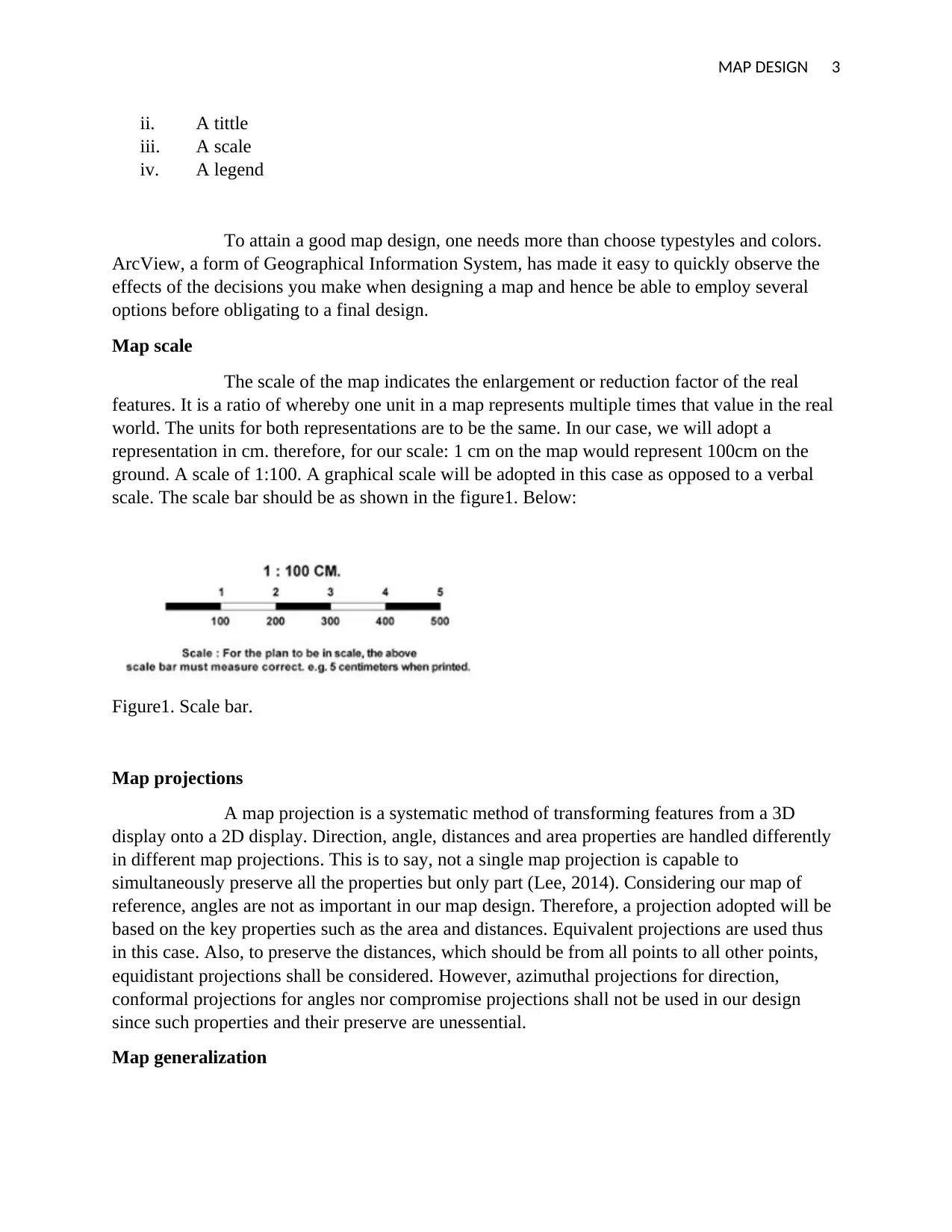
MAP DESIGN 3
ii. A tittle
iii. A scale
iv. A legend
To attain a good map design, one needs more than choose typestyles and colors.
ArcView, a form of Geographical Information System, has made it easy to quickly observe the
effects of the decisions you make when designing a map and hence be able to employ several
options before obligating to a final design.
Map scale
The scale of the map indicates the enlargement or reduction factor of the real
features. It is a ratio of whereby one unit in a map represents multiple times that value in the real
world. The units for both representations are to be the same. In our case, we will adopt a
representation in cm. therefore, for our scale: 1 cm on the map would represent 100cm on the
ground. A scale of 1:100. A graphical scale will be adopted in this case as opposed to a verbal
scale. The scale bar should be as shown in the figure1. Below:
Figure1. Scale bar.
Map projections
A map projection is a systematic method of transforming features from a 3D
display onto a 2D display. Direction, angle, distances and area properties are handled differently
in different map projections. This is to say, not a single map projection is capable to
simultaneously preserve all the properties but only part (Lee, 2014). Considering our map of
reference, angles are not as important in our map design. Therefore, a projection adopted will be
based on the key properties such as the area and distances. Equivalent projections are used thus
in this case. Also, to preserve the distances, which should be from all points to all other points,
equidistant projections shall be considered. However, azimuthal projections for direction,
conformal projections for angles nor compromise projections shall not be used in our design
since such properties and their preserve are unessential.
Map generalization
ii. A tittle
iii. A scale
iv. A legend
To attain a good map design, one needs more than choose typestyles and colors.
ArcView, a form of Geographical Information System, has made it easy to quickly observe the
effects of the decisions you make when designing a map and hence be able to employ several
options before obligating to a final design.
Map scale
The scale of the map indicates the enlargement or reduction factor of the real
features. It is a ratio of whereby one unit in a map represents multiple times that value in the real
world. The units for both representations are to be the same. In our case, we will adopt a
representation in cm. therefore, for our scale: 1 cm on the map would represent 100cm on the
ground. A scale of 1:100. A graphical scale will be adopted in this case as opposed to a verbal
scale. The scale bar should be as shown in the figure1. Below:
Figure1. Scale bar.
Map projections
A map projection is a systematic method of transforming features from a 3D
display onto a 2D display. Direction, angle, distances and area properties are handled differently
in different map projections. This is to say, not a single map projection is capable to
simultaneously preserve all the properties but only part (Lee, 2014). Considering our map of
reference, angles are not as important in our map design. Therefore, a projection adopted will be
based on the key properties such as the area and distances. Equivalent projections are used thus
in this case. Also, to preserve the distances, which should be from all points to all other points,
equidistant projections shall be considered. However, azimuthal projections for direction,
conformal projections for angles nor compromise projections shall not be used in our design
since such properties and their preserve are unessential.
Map generalization
⊘ This is a preview!⊘
Do you want full access?
Subscribe today to unlock all pages.

Trusted by 1+ million students worldwide
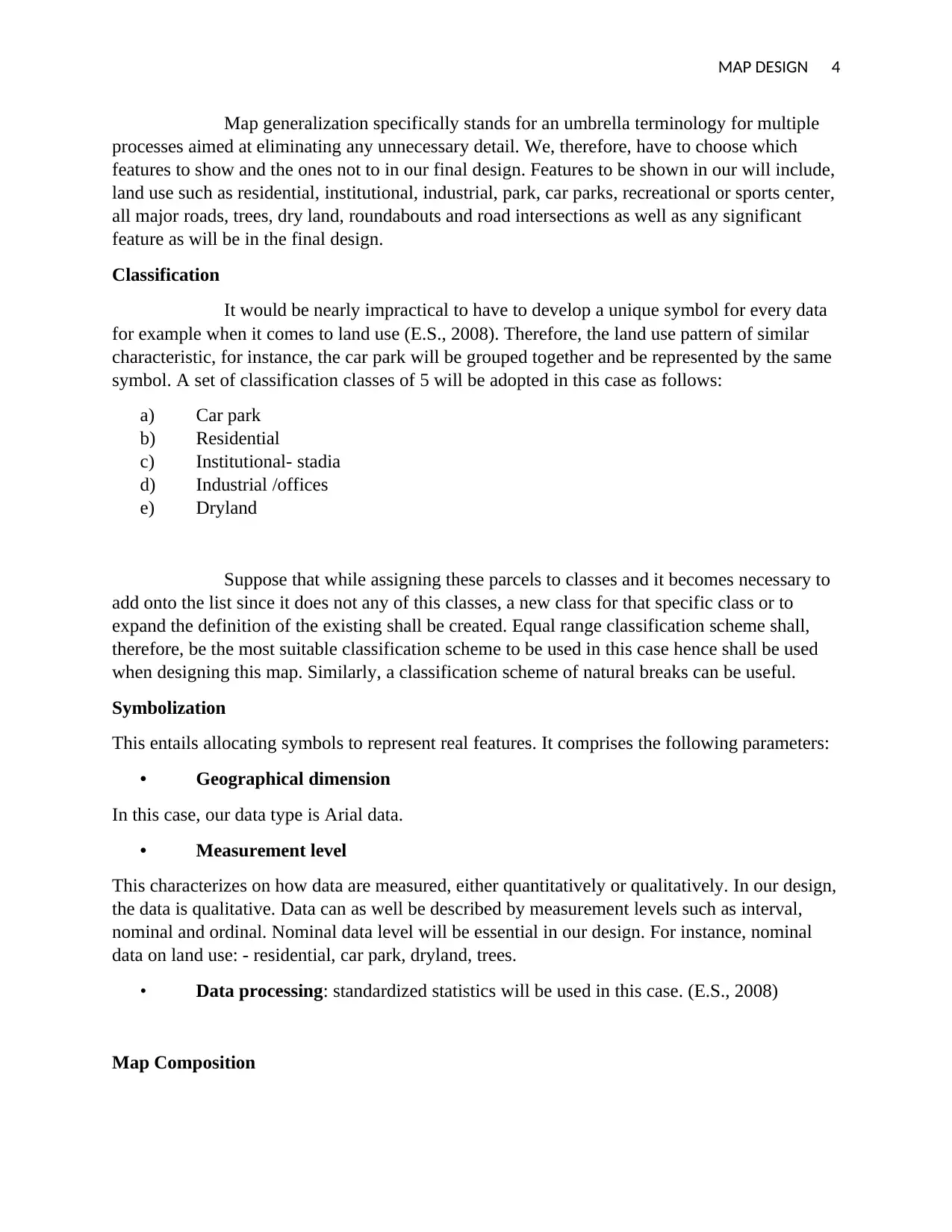
MAP DESIGN 4
Map generalization specifically stands for an umbrella terminology for multiple
processes aimed at eliminating any unnecessary detail. We, therefore, have to choose which
features to show and the ones not to in our final design. Features to be shown in our will include,
land use such as residential, institutional, industrial, park, car parks, recreational or sports center,
all major roads, trees, dry land, roundabouts and road intersections as well as any significant
feature as will be in the final design.
Classification
It would be nearly impractical to have to develop a unique symbol for every data
for example when it comes to land use (E.S., 2008). Therefore, the land use pattern of similar
characteristic, for instance, the car park will be grouped together and be represented by the same
symbol. A set of classification classes of 5 will be adopted in this case as follows:
a) Car park
b) Residential
c) Institutional- stadia
d) Industrial /offices
e) Dryland
Suppose that while assigning these parcels to classes and it becomes necessary to
add onto the list since it does not any of this classes, a new class for that specific class or to
expand the definition of the existing shall be created. Equal range classification scheme shall,
therefore, be the most suitable classification scheme to be used in this case hence shall be used
when designing this map. Similarly, a classification scheme of natural breaks can be useful.
Symbolization
This entails allocating symbols to represent real features. It comprises the following parameters:
• Geographical dimension
In this case, our data type is Arial data.
• Measurement level
This characterizes on how data are measured, either quantitatively or qualitatively. In our design,
the data is qualitative. Data can as well be described by measurement levels such as interval,
nominal and ordinal. Nominal data level will be essential in our design. For instance, nominal
data on land use: - residential, car park, dryland, trees.
• Data processing: standardized statistics will be used in this case. (E.S., 2008)
Map Composition
Map generalization specifically stands for an umbrella terminology for multiple
processes aimed at eliminating any unnecessary detail. We, therefore, have to choose which
features to show and the ones not to in our final design. Features to be shown in our will include,
land use such as residential, institutional, industrial, park, car parks, recreational or sports center,
all major roads, trees, dry land, roundabouts and road intersections as well as any significant
feature as will be in the final design.
Classification
It would be nearly impractical to have to develop a unique symbol for every data
for example when it comes to land use (E.S., 2008). Therefore, the land use pattern of similar
characteristic, for instance, the car park will be grouped together and be represented by the same
symbol. A set of classification classes of 5 will be adopted in this case as follows:
a) Car park
b) Residential
c) Institutional- stadia
d) Industrial /offices
e) Dryland
Suppose that while assigning these parcels to classes and it becomes necessary to
add onto the list since it does not any of this classes, a new class for that specific class or to
expand the definition of the existing shall be created. Equal range classification scheme shall,
therefore, be the most suitable classification scheme to be used in this case hence shall be used
when designing this map. Similarly, a classification scheme of natural breaks can be useful.
Symbolization
This entails allocating symbols to represent real features. It comprises the following parameters:
• Geographical dimension
In this case, our data type is Arial data.
• Measurement level
This characterizes on how data are measured, either quantitatively or qualitatively. In our design,
the data is qualitative. Data can as well be described by measurement levels such as interval,
nominal and ordinal. Nominal data level will be essential in our design. For instance, nominal
data on land use: - residential, car park, dryland, trees.
• Data processing: standardized statistics will be used in this case. (E.S., 2008)
Map Composition
Paraphrase This Document
Need a fresh take? Get an instant paraphrase of this document with our AI Paraphraser
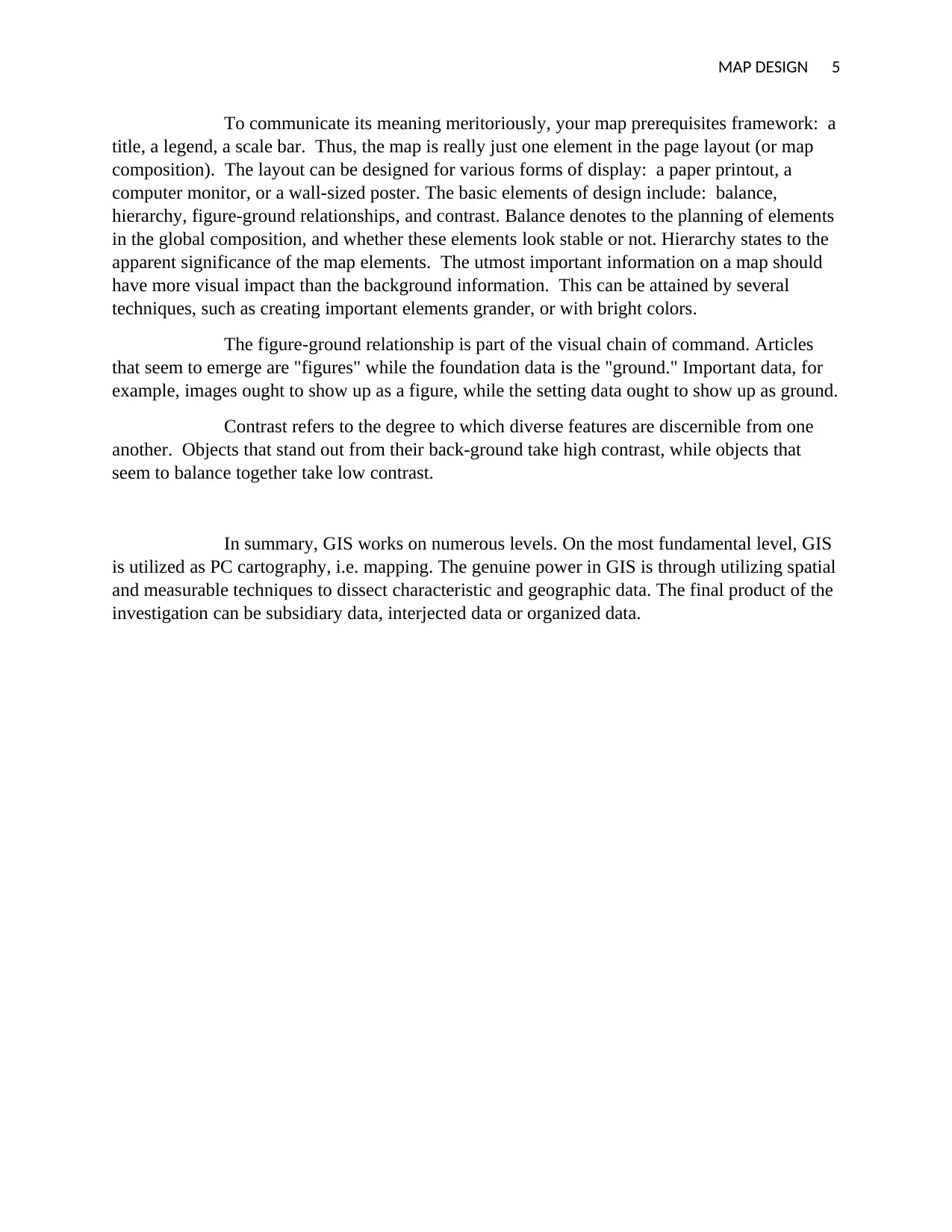
MAP DESIGN 5
To communicate its meaning meritoriously, your map prerequisites framework: a
title, a legend, a scale bar. Thus, the map is really just one element in the page layout (or map
composition). The layout can be designed for various forms of display: a paper printout, a
computer monitor, or a wall-sized poster. The basic elements of design include: balance,
hierarchy, figure-ground relationships, and contrast. Balance denotes to the planning of elements
in the global composition, and whether these elements look stable or not. Hierarchy states to the
apparent significance of the map elements. The utmost important information on a map should
have more visual impact than the background information. This can be attained by several
techniques, such as creating important elements grander, or with bright colors.
The figure-ground relationship is part of the visual chain of command. Articles
that seem to emerge are "figures" while the foundation data is the "ground." Important data, for
example, images ought to show up as a figure, while the setting data ought to show up as ground.
Contrast refers to the degree to which diverse features are discernible from one
another. Objects that stand out from their back-ground take high contrast, while objects that
seem to balance together take low contrast.
In summary, GIS works on numerous levels. On the most fundamental level, GIS
is utilized as PC cartography, i.e. mapping. The genuine power in GIS is through utilizing spatial
and measurable techniques to dissect characteristic and geographic data. The final product of the
investigation can be subsidiary data, interjected data or organized data.
To communicate its meaning meritoriously, your map prerequisites framework: a
title, a legend, a scale bar. Thus, the map is really just one element in the page layout (or map
composition). The layout can be designed for various forms of display: a paper printout, a
computer monitor, or a wall-sized poster. The basic elements of design include: balance,
hierarchy, figure-ground relationships, and contrast. Balance denotes to the planning of elements
in the global composition, and whether these elements look stable or not. Hierarchy states to the
apparent significance of the map elements. The utmost important information on a map should
have more visual impact than the background information. This can be attained by several
techniques, such as creating important elements grander, or with bright colors.
The figure-ground relationship is part of the visual chain of command. Articles
that seem to emerge are "figures" while the foundation data is the "ground." Important data, for
example, images ought to show up as a figure, while the setting data ought to show up as ground.
Contrast refers to the degree to which diverse features are discernible from one
another. Objects that stand out from their back-ground take high contrast, while objects that
seem to balance together take low contrast.
In summary, GIS works on numerous levels. On the most fundamental level, GIS
is utilized as PC cartography, i.e. mapping. The genuine power in GIS is through utilizing spatial
and measurable techniques to dissect characteristic and geographic data. The final product of the
investigation can be subsidiary data, interjected data or organized data.
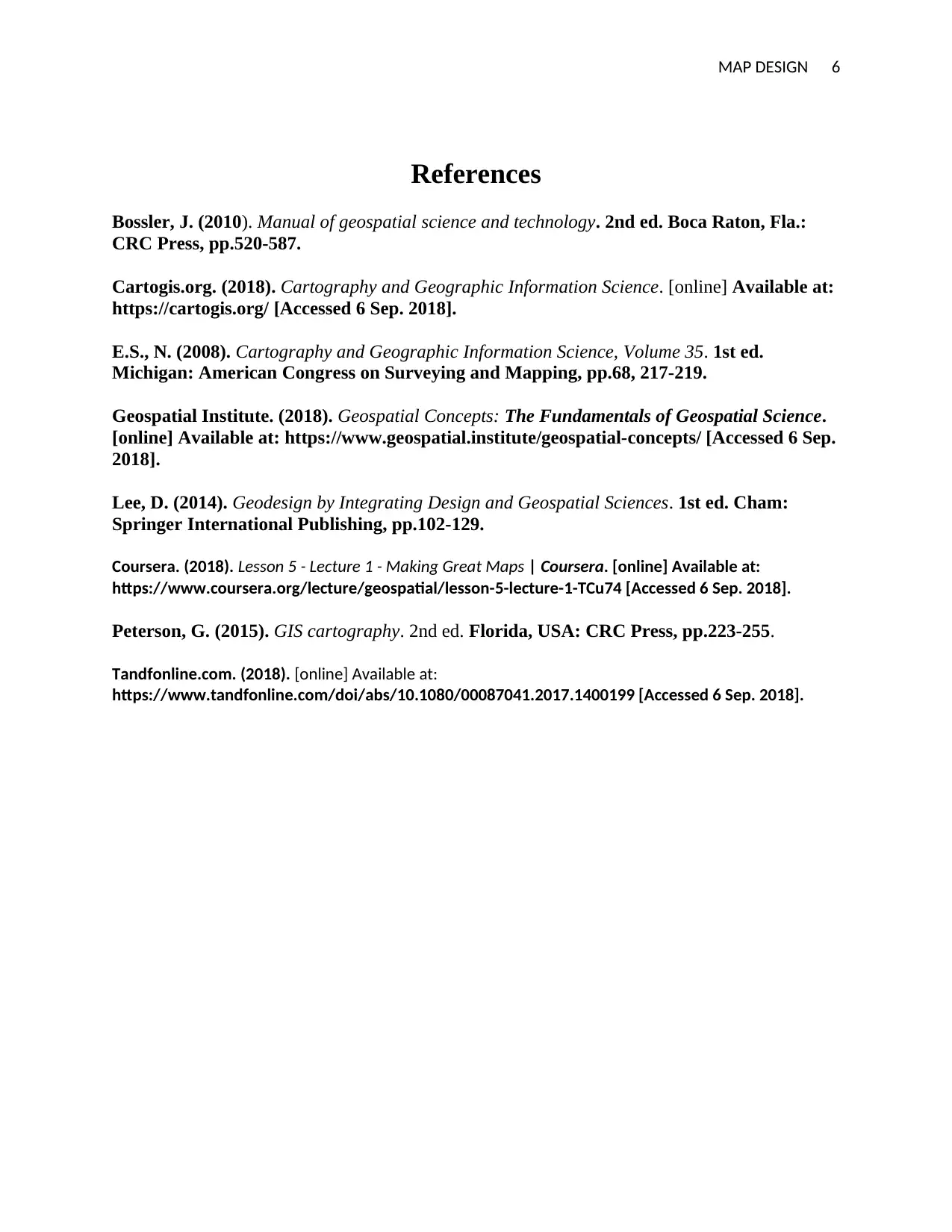
MAP DESIGN 6
References
Bossler, J. (2010). Manual of geospatial science and technology. 2nd ed. Boca Raton, Fla.:
CRC Press, pp.520-587.
Cartogis.org. (2018). Cartography and Geographic Information Science. [online] Available at:
https://cartogis.org/ [Accessed 6 Sep. 2018].
E.S., N. (2008). Cartography and Geographic Information Science, Volume 35. 1st ed.
Michigan: American Congress on Surveying and Mapping, pp.68, 217-219.
Geospatial Institute. (2018). Geospatial Concepts: The Fundamentals of Geospatial Science.
[online] Available at: https://www.geospatial.institute/geospatial-concepts/ [Accessed 6 Sep.
2018].
Lee, D. (2014). Geodesign by Integrating Design and Geospatial Sciences. 1st ed. Cham:
Springer International Publishing, pp.102-129.
Coursera. (2018). Lesson 5 - Lecture 1 - Making Great Maps | Coursera. [online] Available at:
https://www.coursera.org/lecture/geospatial/lesson-5-lecture-1-TCu74 [Accessed 6 Sep. 2018].
Peterson, G. (2015). GIS cartography. 2nd ed. Florida, USA: CRC Press, pp.223-255.
Tandfonline.com. (2018). [online] Available at:
https://www.tandfonline.com/doi/abs/10.1080/00087041.2017.1400199 [Accessed 6 Sep. 2018].
References
Bossler, J. (2010). Manual of geospatial science and technology. 2nd ed. Boca Raton, Fla.:
CRC Press, pp.520-587.
Cartogis.org. (2018). Cartography and Geographic Information Science. [online] Available at:
https://cartogis.org/ [Accessed 6 Sep. 2018].
E.S., N. (2008). Cartography and Geographic Information Science, Volume 35. 1st ed.
Michigan: American Congress on Surveying and Mapping, pp.68, 217-219.
Geospatial Institute. (2018). Geospatial Concepts: The Fundamentals of Geospatial Science.
[online] Available at: https://www.geospatial.institute/geospatial-concepts/ [Accessed 6 Sep.
2018].
Lee, D. (2014). Geodesign by Integrating Design and Geospatial Sciences. 1st ed. Cham:
Springer International Publishing, pp.102-129.
Coursera. (2018). Lesson 5 - Lecture 1 - Making Great Maps | Coursera. [online] Available at:
https://www.coursera.org/lecture/geospatial/lesson-5-lecture-1-TCu74 [Accessed 6 Sep. 2018].
Peterson, G. (2015). GIS cartography. 2nd ed. Florida, USA: CRC Press, pp.223-255.
Tandfonline.com. (2018). [online] Available at:
https://www.tandfonline.com/doi/abs/10.1080/00087041.2017.1400199 [Accessed 6 Sep. 2018].
⊘ This is a preview!⊘
Do you want full access?
Subscribe today to unlock all pages.

Trusted by 1+ million students worldwide
1 out of 6
Your All-in-One AI-Powered Toolkit for Academic Success.
+13062052269
info@desklib.com
Available 24*7 on WhatsApp / Email
![[object Object]](/_next/static/media/star-bottom.7253800d.svg)
Unlock your academic potential
Copyright © 2020–2025 A2Z Services. All Rights Reserved. Developed and managed by ZUCOL.
